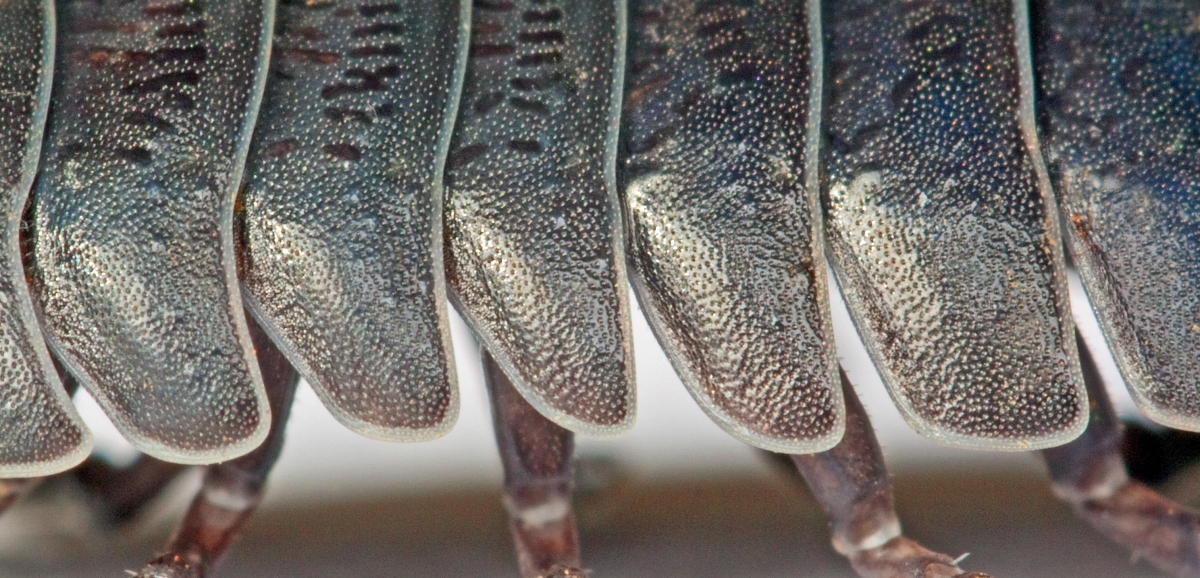Form and Function
The Armadillidium vulgare are earthy colors such as light brown or dark grey in color, in order to blend in with their surroundings (camouflage). They are a member of the phylum arthropoda, which share the synapomorphies of having exoskeletons made of chitin and jointed legs. The exoskeleton provides the organism with protection as well as support and movement because it serves as a site for the muscles to attach to. The exoskeleton of the Armadillidium vulgare is made up of seven overlapping plates (seen in the image above). The plate exoskeleton is made mostly of chitin and it is also supported by calcium carbonate (Seidl, et al. 2012). When the A. vulgare perceive a certain stimulus to be threatening, they curl their bodies into a ball, folding in all 14 of their limbs and antennae, to defend themselves from the threat. This ball form makes it difficult for another organism to pick the A. vulgare up. This inducible defensive (the defense is not present at all times) strategy is called conglobation (Smigel and Gibbs 2008). The A. vulgare may also induce their defense in harsh conditions, such as a very high temperature, to prevent water loss from their bodies (Smigel and Gibbs 2008). Their exoskeletons do not have the waxy cuticle that other insect have so they are very vulnerable to water loss (The Natural Source 1997) which restricts the environments they can inhabit to moist habitats.
They have seven pairs of legs which they use to walk, run, climb and dig (locomotion). This land adaptation differes from many of their water-dwelling relatives who have flipper-like appendages used for swimming (Raham 1986). If an A. vulgare gets flipped onto its back, it has an extremely hard time getting back onto its feet because their backs are so rounded. In order to grow A. vulgare undergo ecdysis (molting) in which they grow a new exoskeleton and shed the old one, similar to the Horseshoe crab and the American lobster who are also members of the phylum Arthropoda. This molting process occurs every few weeks (The Natural Source 1997). They undergo two stages of ecdysis; during the first stage they shed the lower half of the exoskeleton and the upper half during the second stage (American Orchid Society 2003).
The Armadillidium vulgare have compound eyes made up of 15 to 20 eyes (most compound eyes of insects are made up of thousands of small eyes) so they have poor eyesight and require antennae in order to sense their surroundings. They have two pairs of jointed antennae, one large and one small. As the A. vulgare walks it taps the large antennae on the ground in front of it to pick up on smells and find food. The large antennae are also used by the males to find females. The small antennae are called antennules and their function is unknown (Pyers 2005). This species has gills, called pleopods, but are still terrestrial so they need to live in damp habitats in order to keep these gills from drying out. When an A. vulgare is flipped onto its back, two round white organs will be visible. These structures are the pleopods and are made up of pseudotracheae. Air gets trapped within the empty spaces of the pseudotracheae and causes the white color (Raham 1986). If an A. vulgare does dry out it can take up water through a straw-like organ in-between their tails. The water travels up grooves running from the legs up the entire body to the head where the individual can drink it (Raham 1986).
The European A. vulgare has adopted a defensive strategy in which they mimic the colorations of the poisonous black widow spider. This fends off predators that are familiar with the danger that black widow spiders pose because they assume that if the A. vulgare has the same markings, they must be just as dangerous (Raham 1986). This type of mimicry in which a harmless species imitates a harmful one is called batesian mimicry.
Return to Home Discover more on our Reproduction page

